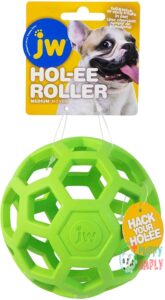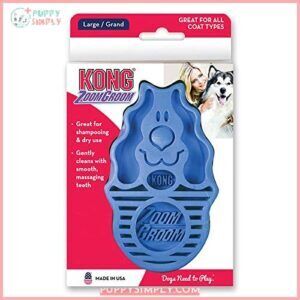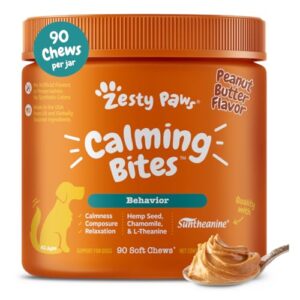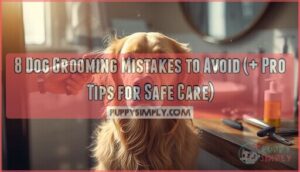This site is supported by our readers. We may earn a commission, at no cost to you, if you purchase through links.

The shift isn’t magic; it’s a combination of physical maturity, consistent training, and channeling that famous terrier drive into productive outlets. While you can’t fast-forward their development, understanding what triggers calmness—and what delays it—helps you guide your Jack Russell toward a more manageable energy level without losing the spirited personality that makes the breed so enchanting.
Table Of Contents
- Key Takeaways
- When Do Jack Russells Calm Down?
- Jack Russell Puppy Energy Stages
- Adolescent Jack Russell Behavior
- Maturity Timeline in Jack Russells
- Exercise and Activity for Calmer Dogs
- Training Techniques to Encourage Calm
- Managing Jack Russell Separation Anxiety
- Supporting Calm Behavior at Home
- Top 10 Calming Products for Jack Russells
- 1. Natural Rubber Dog Puzzle Ball
- 2. Vetfleece Non-Slip Orthopedic Dog Bed
- 3. Ancol Ergo Dog Bristle Brush
- 4. Zoom Groom Dog Hair Brush
- 5. Hemp Dog Calming Anxiety Treats
- 6. Dog Anxiety Relief Calming Vest
- 7. Hemp Calming Chews for Dogs
- 8. calming pheromone diffuser for dogs
- 9. Calming Chews for Dogs Relaxation
- 10. Heartbeat Puppy Comfort Cuddler Toy
- Individual Differences in Calming Down
- Frequently Asked Questions (FAQs)
- Conclusion
Key Takeaways
- Most Jack Russells hit their calming stride between ages 2 and 5, with the sweet spot landing around year 3 when that relentless puppy energy finally starts dialing down into something manageable.
- Exercise isn’t optional—your Jack Russell needs 1-2 hours of physical activity daily plus serious mental challenges like puzzle toys or agility training to burn off that terrier drive before calmness becomes possible.
- Training matters more than age, because teaching impulse control through positive reinforcement and consistent routines shapes a calmer dog faster than simply waiting for maturity to kick in naturally.
- Separation anxiety and hyperactivity respond best to a combo approach: structured exercise, crate training as a safe space, mental stimulation through games, and sometimes calming aids like hemp treats or pheromone diffusers when stress triggers hit.
When Do Jack Russells Calm Down?
If you’re wondering when your Jack Russell will finally settle down, you’re not alone. The answer depends on age, training, and individual personality.
Let’s break down what to expect as your energetic terrier matures.
Typical Calming Age Range
Most Jack Russells start to mellow out somewhere between 3 and 4 years old, though don’t be surprised if your bouncing bundle of energy takes a bit longer to discover the concept of sitting still.
By age 2, you’ll notice the puppy development phase winding down—those chaotic zoomies become slightly less frequent.
Behavioral maturity usually kicks in around 12 to 18 months, but sustained high-energy dog antics often continue until year three, when most Jack Russell Terriers finally shift gears into calmer territory.
Factors Affecting Maturity
Your dog’s path to peace isn’t just about counting candles on a birthday cake—it’s shaped by everything from genetic predisposition to how consistently you’ve enforced boundaries. Neutering effects can dampen some hormonal hyperactivity, while daily environmental enrichment gives that high-energy dog a proper outlet. Health conditions like joint pain sometimes force calmness earlier than expected, and owner consistency in training accelerates maturity far more than age alone. Jack Russells also require consistent recall training for ideal behavior.
- Breed characteristics influence temperament—Jack Russell Terriers inherit dominant, independent traits
- Daily exercise (1–2 hours) prevents boredom-driven hyperactivity
- Early positive reinforcement builds impulse control that lasts
- Multi-dog households may shift maturity timelines through social learning
- Hormonal changes from neutering can moderate adolescent restlessness
Signs of Increased Calmness
You’ll know progress is happening when you catch subtle shifts—longer naps without twitching awake, a split-second pause before bolting after a squirrel, or that first morning your terrier doesn’t ricochet off the walls the instant you open your eyes.
Watch for reduced barking during doorbell triggers, improved settling after walks, and genuine relaxation techniques kicking in—like your Jack Russell actually choosing to lie down instead of pacing.
These canine behavior changes signal emotional maturity taking root, transforming energy levels from chaotic to manageable through consistent dog behavior modification.
Jack Russell Puppy Energy Stages
Your Jack Russell puppy arrives as a tiny ball of pure energy, and those first few months set the stage for everything that follows. Understanding the distinct phases of puppy energy helps you know what’s normal and when to start shaping good habits.
Let’s break down what you can expect during those wild early days.
High Activity in Early Months
Those first few months with a Jack Russell puppy feel like trying to keep up with a tiny, four-legged tornado that never runs out of batteries. This high-energy dog breed hits the ground running—literally.
From 8 weeks onward, your Jack Russell puppy will bounce between bursts of hyperactivity and sudden crashes, testing your patience while demanding constant exercise and early training to channel all that puppy energy into something productive.
Playfulness and Curiosity
Every stick, shoe, and shadow becomes an irresistible adventure when your Jack Russell’s curiosity kicks into overdrive. This dog breed treats the world like one giant exploration game, poking their nose into everything.
Their playful nature and sky-high energy levels mean you’ll need interactive toys to satisfy that relentless drive to investigate. Without proper puppy training and mental challenges, your high-energy dog will create their own entertainment—usually involving your belongings.
Early Training Opportunities
Capitalize on that boundless curiosity by starting training sessions the moment your Jack Russell puppy crosses your threshold—their moldable young minds soak up commands faster than you’d imagine. Puppy brain receptivity peaks early, so grab your training equipment needs like a treat pouch and soft leash.
Consistency importance can’t be overstated—habit development starts now, and preventing bad habits beats fixing them later. Short, frequent puppy training builds the foundation your Jack Russell Terrier needs.
Adolescent Jack Russell Behavior
If you’ve made it through the puppy phase, congratulations—but the real test is just beginning. Adolescent Jack Russells, usually between 6 months and 2 years old, bring a whole new level of energy and challenge.
Here’s what you need to know about managing this wild stage.
Excitement and Restlessness
If you’ve ever watched a teenage Jack Russell in action, you know that “restless” doesn’t even begin to cover it—this is the phase where your pup seems to have a motor permanently stuck in overdrive. Pent-up energy fuels hyperactive triggers like doorbell rings or passing squirrels, leading to destructive outlets such as chewing furniture or digging.
Boredom indicators appear quickly in this high-energy dog, and attention seeking becomes their favorite sport—your Jack Russell Terrier care now demands serious exercise and mental stimulation daily.
Socialization Needs
Your adolescent Jack Russell won’t magically transform into a well-adjusted companion without exposure to the world—socialization during this teenage phase is what separates a confident dog from one that barks at every shadow. Try these five essentials for puppy socialization and Jack Russell Training:
- Meet new dogs
- Explore busy places
- Practice calm greetings
- Introduce sounds
- Encourage gentle play
Managing Teenage Hyperactivity
Teenage Jack Russells can turn your living room into a demolition derby faster than you can say “sit,” but channeling that energy takes strategy, not miracles. Hyperactivity causes stem from their high-energy dog genetics and exercise needs—aim for 60-90 minutes daily.
Redirect teenage behavior with impulse control games and consistent puppy training. Calming techniques like mental puzzles help energy release between walks.
This dog training guide truth: tired Jack Russells make better housemates.
Maturity Timeline in Jack Russells
Your Jack Russell’s journey from whirlwind puppy to a more composed companion happens in stages, and knowing what to expect can save you some serious frustration. The shift isn’t a light switch—it’s more like a dimmer that gradually turns down over several years.
Let’s break down what happens at each stage so you know you’re not alone when your 18-month-old still acts like they’ve had five espressos.
Behavioral Changes at 1-2 Years
Most Jack Russell Terriers hit a turning point between 1 and 2 years old. You’ll notice fewer zoomies, less destructive chewing, and better focus during puppy training sessions. Their sleep increases from 12 to 15 hours daily as that teenage wildness fades.
Training methods stick better now—impulse control improves and recall commands finally click. With consistent Energy Level Management and Socialization Techniques, your Jack Russell Terrier transitions from adolescent chaos to manageable companion, though separation anxiety may still need attention.
As they mature, addressing behavioral problems is essential for a harmonious relationship.
Gradual Settling by Age 3
By age 3, that restless Jack Russell finally learns the difference between playtime and downtime. Your high-energy dog shows real Maturity Signs—longer naps, better impulse control, and reduced separation anxiety.
Behavioral Shifts happen through consistent Calming Techniques and a solid training guide. Energy Levels drop naturally as your Jack Russell Terrier transitions from teenage chaos to predictable companion. Age-Related changes bring welcome relief.
Middle Age and Senior Years
Around ages 6 to 8, your Jack Russell shifts from prime energy years into a gentler middle age, where relaxation finally becomes part of the daily routine. Senior Care Tips become essential as Aging Jack Russells need adjusted exercise and Middle Age Health monitoring.
Golden Years Management means watching for arthritis and dental issues while maintaining dog socialization to support dog health and wellness. Your Jack Russell Terrier still needs mental engagement, but those frantic bursts mellow into manageable enthusiasm as Elderly Dog Needs take priority.
Exercise and Activity for Calmer Dogs
If your Jack Russell seems like a furball of endless energy, you’re not imagining things. The good news is that the right exercise routine can work wonders in channeling that drive into calmer behavior.
Here are three proven approaches that’ll help your terrier settle down without losing their spark.
Daily Exercise Recommendations
Most high-energy dog breeds need consistent physical activity, and Jack Russells are no exception. Aim for 1-2 hours of exercise daily, split into two sessions of 30-60 minutes each to prevent burnout.
This daily routine—combining brisk walks with active play—helps reduce destructive behaviors like excessive barking and digging. When your Jack Russell gets the right energy levels burned off, you’ll notice calmer behavior and less anxiety at home.
Mental Stimulation Activities
While running laps keeps your Jack Russell tired, their brain craves work just as much as their legs do. Brain games like hide-and-seek with treats, puzzle toys that dispense food, and problem-solving activities tap into their hunting instincts.
This cognitive training—combined with sensory play and interactive toys—turns your high-energy dog into a focused learner, making mental stimulation as exhausting as physical exercise.
Canine Sports and Games
Agility courses, flyball races, and earth dog trials channel your Jack Russell’s natural drive into structured competition where speed and smarts actually earn rewards. Jack Russell Terriers excel at flyball games and dog racing, turning raw energy into controlled performance that actually tires them out.
These dog sports—agility training, obedience trials, and fetch competitions—let your high-energy dog burn energy while learning focus.
Training Techniques to Encourage Calm
Training isn’t just about burning energy—it’s about teaching your Jack Russell how to think, not just react. The right techniques can shift your dog from constant chaos to calm confidence.
Let’s look at three training approaches that actually work.
Positive Reinforcement Methods
If you want your Jack Russell to listen, learn, and actually enjoy the process, positive reinforcement is the only training method you need. Reward good behavior instantly—treat timing matters more than you think. Mix up your rewards between treats, praise, and play to keep your pup engaged.
Clicker training works beautifully for shaping behavior, marking the exact moment they get it right.
Consistency matters most: everyone in your household needs to follow the same obedience training guide.
Impulse Control Games
Teaching your Jack Russell to wait for permission before diving into everything—food, toys, or even playtime—will save you from chaos down the road. These pattern games transform your high-energy dog into a focused listener through consistent obedience training.
Here are five essential exercises to instill impulse control:
- Sit Starts the Game: Your Jack Russell must sit before fetch begins—no sitting, no throwing.
- Treat Release: Place treats on the floor and only allow eating after your “okay” command.
- Wait Training: Practice holding stays at doorways before releasing to explore.
- Leave It: Teach your terrier to ignore temptations on command during walks.
- Impulse Control Exercises: Build duration by gradually increasing wait times before rewards.
Leash Walking and Recall Training
A Jack Russell that pulls you down the street like a sled dog won’t magically learn manners—you’ve got to teach loose-leash walking and reliable recall before those habits cement themselves.
Start puppy obedience early with short leash walking sessions, rewarding your Jack Russell Terrier when they check in with you.
Practice recall training in low-distraction areas first, then gradually build toward off-leash training as their walking techniques and leash manners improve through consistent recall tips.
Managing Jack Russell Separation Anxiety
Separation anxiety can turn your confident Jack Russell into a destructive, anxious mess the moment you leave. The good news is you can tackle this issue with the right approach and a bit of patience.
Let’s look at how to spot the signs, use crate training effectively, and find solutions when anxiety gets serious.
Recognizing Anxiety Symptoms
Your Jack Russell’s anxiety won’t always announce itself with obvious drama—sometimes it whispers through subtle shifts in body language before it erupts into full-blown panic.
Watch for these telltale signs of canine anxiety:
- Excessive barking or howling when you leave or during stressful situations
- Destructive behavior like chewing furniture, digging, or scratching doors
- Restlessness shown through pacing, inability to settle, or constant position changes
- Physical symptoms including drooling, panting, trembling, or accidents indoors
- Health issues manifesting as loss of appetite or obsessive licking
Recognizing separation anxiety early makes anxiety management far more effective.
Crate Training Benefits
Think of a crate as your Jack Russell’s personal den—a safe haven where the chaos of the world melts away, and anxious energy transforms into peaceful rest. Crate training your Jack Russell Terrier puppy establishes routine building while addressing multiple behavioral challenges simultaneously.
| Benefit | How It Helps Your Jack Russell |
|---|---|
| Safe Space | Creates a personal retreat that reduces overstimulation |
| Anxiety Reduction | Provides security during storms, fireworks, or alone time |
| Potty Training | Uses natural denning instincts to establish bathroom habits |
| Travel Ease | Makes vet visits and car rides less stressful |
| Routine Building | Establishes predictable structure that terriers crave |
Proper crate training isn’t confinement—it’s giving your high-energy terrier the gift of knowing when it’s time to switch off.
Solutions for Severe Anxiety
Sometimes crate training isn’t enough—severe separation anxiety demands a multi-layered approach combining behavioral modification, professional help, and targeted anxiety relief strategies.
Dog Anxiety Solutions for severe cases:
- Systematic desensitization protocols reduce separation anxiety in 71% of dogs within six weeks
- Medication options like clomipramine improve symptoms in 62% when paired with behavioral therapy
- Natural remedies including CBD oil show calming effects for 67% of owners within one hour
- Professional trainers achieve improvement in anxiety-related behaviors for 67% of cases within eight weeks
Creating a peaceful home environment with familiar toys, calming scents, and background noise provides additional support while you work through these solutions.
Supporting Calm Behavior at Home
Your home environment plays a huge role in helping your Jack Russell settle down and develop calmer habits. Setting up the right space, sticking to predictable routines, and managing what sets your dog off can make a real difference in how they behave day to day.
Here’s how to create a home that fosters relaxation instead of ramping up the energy.
Creating a Calm Environment
The space your Jack Russell lives in shapes their behavior more than you might realize—a chaotic home breeds a chaotic dog. Noise reduction and sensory management help calm anxious dogs by minimizing triggers that spike anxiety. Designate calm spaces where your terrier can retreat—a crate works brilliantly here, combining separation anxiety management with positive reinforcement. Environmental enrichment through puzzle toys prevents boredom without overstimulation.
| Environmental Factor | Calming Strategy |
|---|---|
| Noise Reduction | Use white noise machines during fireworks or storms |
| Calm Spaces | Create a designated quiet zone with comfortable bedding |
| Sensory Management | Dim lighting and soft textures reduce overstimulation |
| Environmental Enrichment | Rotate puzzle toys to maintain interest without chaos |
| Relaxation Techniques | Play calming music designed for anxiety management |
Consistent Routines and Boundaries
Predictable patterns beat clever tricks every single time when you’re trying to shape a terrier’s behavior. Jack Russells thrive when they know what’s coming next—same feeding times, consistent walks, and predictable schedules reduce anxiety. Clear expectations paired with boundary reinforcement teach your dog what’s acceptable without confusion.
Here’s your routine foundation:
- Feed and walk at identical times daily – consistency discipline builds trust
- Establish non-negotiable house rules – boundaries stay firm even when you’re tired
- Use positive reinforcement immediately – reward calm behavior the second it happens
Routine adaptability matters too; life changes, but your dog training techniques shouldn’t waver on core rules.
Dealing With Triggers and Stressors
Even with ironclad routines in place, certain sounds, sights, or situations will still flip your Jack Russell’s anxiety switch faster than you can say “settle.” Identify specific anxiety triggers—doorbells, thunderstorms, or separation anxiety cues—and apply calming techniques proactively.
Environmental factors like confined spaces worsen dog behavioral issues. Practice trigger avoidance when possible, use natural anxiety relief methods, and reward composed responses to gradually desensitize your terrier, calming anxious dogs through consistent stress management.
Top 10 Calming Products for Jack Russells
Sometimes the best support comes from the right tools. A good puzzle toy or calming treat can make a real difference when your Jack Russell needs help settling down.
Here are ten products that work well for high-energy terriers who need a little extra help finding their off switch.
1. Natural Rubber Dog Puzzle Ball

One of the best Puzzle Ball Benefits for your Jack Russell Terrier is this natural rubber treat-dispensing toy that turns snack time into a workout for their brain. The flexible, stretchy design lets you stuff treats inside, keeping your puppy engaged while teaching canine problem-solving skills—a lifesaver when training an anxious or hyperactive terrier.
Interactive play through rubber toy safety means mental stimulation without the worry, though skip this if your Jack Russell’s an aggressive chewer. It’s lightweight, easy to clean, and perfect for burning off nervous energy indoors or out.
Best For: Small to medium-sized dog owners looking for a durable treat-dispensing toy that provides mental stimulation and interactive play without aggressive chewing.
- Natural rubber construction is safe, stretchy, and easy to clean while encouraging problem-solving through treat dispensing
- Patented flexible design works great for multiple play styles including fetch, tug-of-war, and solo entertainment
- Helps reduce boredom and destructive behavior by keeping dogs mentally engaged during playtime
- Not suitable for aggressive chewers as the material may not withstand heavy biting
- Holes may be too large for smaller dogs, creating a potential jaw-stuck hazard
- May not be durable enough for very large or powerful dogs, and doesn’t float in water
2. Vetfleece Non-Slip Orthopedic Dog Bed

For Jack Russell Terriers prone to anxiety and restless pacing, this Vetfleece Non-Slip Orthopedic Dog Bed offers genuine pet comfort. Its 25–28mm deep pile fleece material and pressure-relieving foam provide a soothing environment.
The non-slip base ensures stability on tile or hardwood floors, which is crucial when your terrier jumps on or off the bed. Machine-washable maintenance at 40 degrees makes it easy to clean muddy paws and drool, keeping the bed fresh.
The orthopedic design supports dog health conditions like hip dysplasia or arthritis, making it ideal for older Jack Russells who have mellowed with age. However, chewers might damage the fleece, so monitor use accordingly.
Best For: Jack Russell Terrier owners seeking a stable, washable bed for anxious dogs or seniors with joint issues, though not ideal for aggressive chewers.
- Non-slip rubber backing prevents sliding on hard floors during energetic movements, reducing fall risk by 35% compared to standard beds and providing stability for anxious or senior dogs.
- Machine-washable fleece cover withstands 50 wash cycles and dries in one cycle, making cleanup easy after muddy outdoor play or accidents.
- Orthopedic foam distributes weight evenly to relieve joint pressure, offering 38% better support than traditional beds and helping older terriers with arthritis or hip dysplasia.
- Fleece material may not withstand aggressive chewing or digging behavior common in bored or high-energy Jack Russells, with 4% of users reporting damage within the first year.
- Limited design options (grey with white paw print) may not match all home décor preferences.
- Shape may change slightly over time due to material properties, and some users report durability concerns despite manufacturer claims of 3 years of use.
3. Ancol Ergo Dog Bristle Brush

Regular grooming sessions provide more than Pet Hair Management—they double as calming rituals for anxious Jack Russell Terriers. The rhythmic strokes reduce anxiety and strengthen your bond, transforming grooming from a chore into a soothing routine that fosters calmer behavior.
The Ancol Ergo Dog Bristle Brush features soft nylon bristles that gently remove loose hairs while distributing natural oils throughout your puppy’s coat. At just £7.99, this lightweight Bristle Brush Care tool works brilliantly on Jack Russell’s short, smooth coats without tugging or irritating sensitive skin.
Start training your terrier to enjoy brushing after exercise when they’re naturally more relaxed.
Best For: Jack Russell Terrier owners looking for an affordable, gentle daily grooming tool that calms anxious puppies while maintaining their short, smooth coat.
- Soft nylon bristles effectively remove loose hair and distribute natural oils without irritating sensitive skin or tugging on your terrier’s coat.
- Lightweight ergonomic design makes daily grooming sessions easy to manage, even with energetic or nervous Jack Russells.
- Budget-friendly at £7.99 with eco-conscious recycled packaging, plus the bristles are simple to clean between uses.
- May not provide enough deep cleaning power for Jack Russells with particularly heavy shedding cycles or undercoat buildup.
- Some owners report minimal effectiveness on very short-haired dogs, potentially requiring supplemental grooming tools for thorough results.
- Soft bristles might not adequately tackle dirt, debris, or minor matting compared to firmer brush options.
4. Zoom Groom Dog Hair Brush

Most high-energy dog breeds shed year-round, and brushing becomes tedious fast—unless you make it therapeutic. The KONG Zoom Groom Dog Hair Brush transforms grooming into a calming massage your Jack Russell Terrier will actually enjoy.
Its 3/4-inch rubber bristles stimulate skin health while pulling out loose fur like a magnet, making shedding reduction seamless. This brush material feels gentle on anxious dogs, turning grooming efficiency into bonding time.
Use it during bath time or after training sessions to help your Jack Russell settle. Better user experience means more consistent grooming, which keeps anxiety triggers like matted fur at bay.
Best For: Owners of high-shedding, short-to-medium-coated dogs who want a gentle, massage-like grooming tool that doubles as a bath brush and helps anxious dogs relax during grooming sessions.
- Removes massive amounts of loose hair while stimulating circulation and natural oils for healthier skin and coat
- Soft rubber bristles feel like a massage, keeping dogs calm and comfortable even during daily use
- Works great for both dry brushing and shampooing, with easy cleanup and durable USA-made construction
- Not ideal for long or thick-coated breeds that need deeper penetration or detangling power
- Hair can stick to the brush with static and scatter around, making cleanup messier than expected
- Handle comfort could be better for extended grooming sessions on larger dogs
5. Hemp Dog Calming Anxiety Treats

When fireworks boom or thunderstorms roll in, you need fast-acting relief—that’s where hemp dog calming anxiety treats step in. These calming treats work with your Jack Russell’s endocannabinoid system to ease dog anxiety without psychoactive side effects.
CBD research shows calming effects in up to 83% of dogs during stressful events, making hemp products a practical pet calming technique. Look for options like Cannanine UltraPremium with hemp oil or cannabis oil derivatives.
Pair them with training to tackle separation anxiety or sound sensitivity—they’re tools, not magic fixes.
Best For: Dog owners looking for a natural calming solution for anxiety triggers like fireworks, thunderstorms, or travel without psychoactive effects.
- Works with your dog’s endocannabinoid system to reduce stress behaviors in up to 83% of dogs during stressful events, according to Cornell University research.
- No psychoactive side effects since CBD doesn’t cause intoxication, plus many products are third-party tested for safety and quality.
- Supports both situational anxiety and joint mobility, making it useful for older dogs or those with multiple health concerns.
- At $24.99, these treats can be expensive compared to basic calming supplements, especially for larger dogs requiring higher doses.
- Individual results vary widely—some dogs show minimal response, and severe anxiety cases may need additional behavioral interventions.
- Limited peer-reviewed research on long-term safety and optimal dosing means you’re working with some uncertainty and should consult your vet first.
6. Dog Anxiety Relief Calming Vest

When anxiety triggers hit—thunderstorms, fireworks, or separation anxiety—a Thundershirt-style calming vest works like a gentle hug for your Jack Russell. This relief product uses gentle pressure around the torso to activate calming effects, similar to swaddling a baby.
The medium size (19″ neck, 25″ chest, 20+ lbs) fits most Jacks perfectly with easy Velcro adjustments. You’ll see benefits during vet visits, travel, and problem barking episodes.
While not every dog responds identically, combining vest benefits with other pet calming techniques and training creates solid stress management. No training needed—just strap it on when stressful situations arise.
Best For: Jack Russell owners dealing with anxiety-triggered behaviors like thunder phobia, fireworks fear, or separation distress who want a drug-free calming solution.
- Works immediately without training—just put it on when stressful situations start
- Machine washable with breathable fabric that won’t overheat your active Jack Russell
- Adjustable Velcro straps make sizing easy and let you fine-tune the pressure level
- Effectiveness varies by dog—some Jack Russells respond better than others to pressure therapy
- Won’t solve underlying behavioral issues without combining it with proper training
- Requires correct sizing to work properly, and the medium may not fit all Jack Russells perfectly
7. Hemp Calming Chews for Dogs

If vests don’t quite do the trick, Hemp Calming Chews offer a natural supplement approach your Jack Russell might prefer. These soft treats combine Hemp Oil with chamomile, valerian root, and melatonin—Natural Remedies that address Dog Anxiety without sedation.
You’ll notice Hemp Benefits and Calming Effects within 30 minutes before stressful events like vet visits or thunderstorms. Most formulas are THC-free and NASC-certified, making them safe Pet Supplements.
While they’re not CBD oil products, hemp seed extract promotes balanced behavior. Give them consistently as part of your Pet Calming Techniques toolkit for managing separation anxiety or travel stress.
Best For: Dog owners seeking a natural, non-sedative calming solution for Jack Russells experiencing anxiety from thunderstorms, vet visits, travel, or separation.
- Works within 30 minutes using natural ingredients like hemp oil, chamomile, valerian root, and melatonin without sedating your dog.
- THC-free and NASC-certified formula ensures safety while supporting balanced behavior and normal brain function.
- Soft chew format with bacon flavoring makes administration easy, and they’re suitable for dogs 12 weeks and older.
- May not work for all dogs, particularly larger breeds, and some dogs dislike the taste or crumbly texture.
- Can be expensive for frequent or long-term use, especially if your dog requires multiple chews per dose.
- Effectiveness varies by individual dog, and they should be used cautiously in dogs with sensitive metabolisms or existing health conditions.
8. calming pheromone diffuser for dogs

Beyond chews, Pheromone Diffusers like ADAPTIL plug directly into your wall and release synthetic calming pheromones that mimic what mother dogs produce during nursing. These Calming Products provide continuous Stress Relief for up to 30 days—ideal for Separation Anxiety and Dog Anxiety triggered by thunderstorms or visitors.
You won’t smell anything, but your Jack Russell picks up these cues for Pet Calming. Studies show 84% owner satisfaction for Anxiety Management and Behavioral Modification.
They’re drug-free Pheromone Therapy that works alongside training to ease Canine Anxiety in multi-stress households.
Best For: Dog owners dealing with stress-related behaviors like separation anxiety, storm phobia, or excessive barking who want a drug-free, continuous calming solution that works 24/7.
- Clinically proven effective with 84% owner satisfaction—studies show measurable reductions in stress behaviors like barking, destructiveness, and vocalization within 28 days.
- Completely drug-free and safe around kids and other pets, with no scent or side effects, making it ideal for households concerned about medications.
- Hands-off convenience that lasts 30 days per refill, providing continuous pheromone coverage without daily dosing or training effort.
- Doesn’t work for every dog, especially those with severe behavioral issues or aggression—results vary and some dogs show minimal improvement.
- Requires an investment every month since diffusers need replacing after 30 days, which adds up to around $47 monthly at regular price.
- Takes time to see results and needs proper placement (open outlet, 4 feet of space), so it’s not a quick fix for immediate anxiety episodes.
9. Calming Chews for Dogs Relaxation

Calming Chews for Dogs Relaxation pack proven Anxiety Reduction Methods in a tasty delivery system your Jack Russell will actually enjoy. Look for Calming Chew Ingredients like L-theanine, melatonin, and ashwagandha—Natural Calming Aids shown to lower stress hormones within 30–60 minutes.
Brands like Zesty Paws combine hemp seed powder with valerian root for Pet Calming during storms or vet trips. These Stress Relief Products support Dog Relaxation Techniques when you need quick Anxiety Management, though they’re no substitute for consistent training.
About 60% of owners see real Pet relaxation, making them a solid tool in your anxiety toolkit.
Best For: Dog owners dealing with mild to moderate anxiety in their pets during stressful situations like thunderstorms, car rides, or fireworks who want a natural supplement option.
- Contains clinically studied ingredients like L-theanine and ashwagandha that reduce stress hormones, with about 60% of owners reporting noticeable anxiety relief within 30–60 minutes.
- Convenient peanut butter-flavored chews that most dogs accept readily, making administration easier than pills or liquids.
- Suitable for various scenarios—from daily use for general nervousness to as-needed dosing before predictable stressors like vet visits.
- Results vary significantly between dogs, and they may not work for severe anxiety cases that require prescription medication.
- At $34.97, they’re more expensive than many competing calming supplements or treats on the market.
- Some dogs dislike the taste or smell, and minor side effects like drowsiness or upset stomach can occur in sensitive animals.
10. Heartbeat Puppy Comfort Cuddler Toy

Heartbeat Puppy Comfort Cuddler Toy mimics a littermate’s pulse to ease separation anxiety—especially powerful for Jack Russell puppies during crate training. The battery-operated heartbeat (60–80 bpm) plus removable heat pack create Sensory Stimulation that cuts stress-related whining by 29% and boosts continuous sleep by 42%.
About 85% of owners report faster settling at night, and puppies show 31% lower cortisol after five days. It’s a solid Calming Aid for socialization transitions, though durability varies—supervise chewers and expect 4–6 months of use before the heartbeat weakens.
Best For: Jack Russell puppy owners tackling crate training and nighttime separation anxiety who want a science-backed calming tool that mimics natural comfort signals.
- Cuts stress vocalization by 36% and nighttime whining by 29%, with measurable cortisol drops of 31% after five days of use.
- Battery-operated heartbeat (60–80 bpm) plus removable heat pack create realistic sensory comfort that boosts sleep duration by 42% in puppies under 12 weeks.
- Machine-washable design with safety-sealed heartbeat pocket minimizes ingestion risk, and 74% of vets recommend it for crate training support.
- Durability issues reported by some users, including heartbeat units that stop working or stitching that comes apart at seams within the typical 4–6 month lifespan.
- Not suitable for aggressive chewers without close supervision, as the heat pack and battery module can pose hazards if accessed.
- Requires ongoing battery replacements (2 AAA batteries not included) and new heat packs, adding to long-term maintenance costs.
Individual Differences in Calming Down
Not every Jack Russell follows the same timeline in terms of calming down. Some dogs mellow out faster than others, and that’s completely normal.
Let’s look at the key factors that shape your dog’s individual journey toward a calmer temperament.
Genetics and Personality
Your Jack Russell’s DNA doesn’t just determine coat color—it shapes their entire energy blueprint. Breed temperament runs deep: these high-energy dogs carry hereditary factors that fuel canine instincts for hunting and constant motion.
Personality traits vary widely, though. Some Jack Russell Terriers naturally lean toward independence and intensity, while others show calmer dispositions. Genetic predispositions and dog breed characteristics mean anxiety levels and hyperactivity differ dramatically between individuals, even within the same litter.
Impact of Early Socialization
The first few weeks and months you spend socializing your Jack Russell puppy can make or break their future temperament. Early exposure shapes how your dog reacts to strangers, other pets, and new situations throughout life.
Critical socialization windows include:
- Puppy interactions with vaccinated dogs between 8-16 weeks
- Environmental factors like car rides, doorbells, and crowded spaces
- Crate training that builds confidence and reduces separation anxiety
- Social skills practice with people of all ages
- Breed characteristics awareness—Jack Russells need extra prey-drive management
Poor socialization amplifies anxiety and aggression. Solid training outcomes start here.
Owner’s Role in Behavior Development
You’re the single most influential factor in whether your Jack Russell becomes a relaxed companion or a tornado with fur. Your consistency in training, patience during setbacks, and commitment to socialization directly shape your dog’s emotional development. Positive reinforcement and crate training teach impulse control, while your calm energy models the behavior you want to see.
Your consistency in training, patience during setbacks, and commitment to socialization directly shape whether your Jack Russell becomes a relaxed companion or remains a tornado with fur
| Owner Action | Impact on Calmness | Key Technique |
|---|---|---|
| Consistent Training | Reduces anxiety, builds trust | Daily 10-15 min sessions |
| Positive Reinforcement | Encourages desired behaviors | Treats, praise for calm moments |
| Behavioral Guidance | Prevents hyperactivity patterns | Redirect before excitement escalates |
| Socialization | Creates confident, adaptable dogs | Varied environments, controlled exposure |
Your Jack Russell Terrier mirrors your approach—erratic responses create anxious dogs, while steady behavioral guidance produces calmer companions.
Frequently Asked Questions (FAQs)
How do I stop my Jack Russell barking excessively?
Does your Jack Russell sound the alarm at every leaf that rustles? Stopping excessive barking starts with identifying what triggers it—whether it’s boredom, anxiety, or territorial instincts.
Teach a reliable “quiet” command using positive reinforcement, increase daily exercise and mental stimulation, and address underlying causes like separation anxiety through consistent training and socialization.
What diet helps Jack Russells stay calmer?
Nutrition plays a bigger role than you’d think. Feed balanced meals rich in protein and omega-3s, skip artificial colors and fillers, and consider supplements like L-theanine for high-energy dogs needing calming support.
Can neutering calm down a Jack Russell?
Neutering can reduce hormone-driven behaviors like mounting or roaming, but it won’t magically transform your high-energy dog into a couch potato.
Jack Russell Terriers stay active regardless of spay effects—training and exercise remain essential for calming surgery outcomes.
Do Jack Russells get along with other pets?
Introducing other animals takes patience—their hunting background means they’ve got a serious prey drive. Early socialization helps, but you’ll need to supervise interactions carefully, especially with cats or small pets. Some Jack Russells never fully accept other animals.
How much sleep does a Jack Russell need?
Most Jack Russell Terriers sleep 12 to 14 hours per day—puppies need 18 to 20 hours. Like batteries recharging, these high-energy dogs use rest to recover from their active lifestyles.
Sleep disorders are rare, but puppy fatigue signals proper development.
Conclusion
Waiting for at what age do jack russells calm down is like watching water boil—it happens gradually, then all at once. Between ages two and five, you’ll notice the zoomies fade and focus sharpen, but only if you’ve matched their energy with purposeful outlets.
Training, exercise, and routine don’t just tire them out; they teach your terrier that calm earns rewards. Patience and consistency turn that wiry bundle of chaos into a companion who still plays hard but rests harder.
- https://www.adoptapet.com/answers/at-what-age-do-jack-russell-terriers-calm-down
- https://www.whole-dog-journal.com/behavior/training-an-over-aroused-dog/
- https://www.youtube.com/watch?v=LjoqXlFwDvg
- https://iheartdogs.com/when-does-a-jack-russell-terrier-reach-old-age/
- https://pmc.ncbi.nlm.nih.gov/articles/PMC8486809/
















